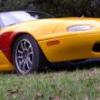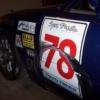
1.6 Data & Testing
#261

 Posted 09-08-2015 07:07 PM
Posted 09-08-2015 07:07 PM

Bench, I wasn't suggesting, or thinking you were suggesting, anything about a lighter flywheel for actual weight reduction. The stuff you quoted attempts to make the physics more "accessible" (hate that term) by equating it to reducing weight rather than increasing power. Just another way to think about the benefits in terms of acceleration, but I think not really helpful. And it isn't that the benefit falls at higher ENGINE RPM, (quite the opposite in fact), but rather that it falls off as the *rate of change* in RPM decreases. It's all about the length of time available to achieve a fixed amount of work.
Tom, if you can do the math on the theoretical benefits of shaving roughly 2.5 lbs from the outer circumference of the 1.6 flywheel, please take the time to do so and we can compare results. I've been working on it and that's why I requested some 2nd gear data in another topic (no luck), but I don't claim to be qualified to swear the results will be accurate in absolute terms. I "know" how it works and the approximate scale much as I know that cooler intake air provides the porential for more power. I've also followed arguments about it more than once and reviewed the math and concluded for myself who had it right. But what I will offer in this case still relies on the assumption that someone else's basic calculations of joules are correct and that how I then apply them is valid. Any and all help in determining the true value of proposed changes is welcome.


#262

 Posted 09-08-2015 07:45 PM
Posted 09-08-2015 07:45 PM

-tch
Build: www.tomhampton.info
video: vimeo.com/tomhampton
Support: X-Factor Racing
I didn't lose, I just got outspent!



#263

 Posted 09-08-2015 11:38 PM
Posted 09-08-2015 11:38 PM

"Bench, I wasn't suggesting, or thinking you were suggesting, anything about a lighter flywheel for actual weight reduction. The stuff you quoted attempts to make the physics more "accessible" (hate that term) by equating it to reducing weight rather than increasing power. Just another way to think about the benefits in terms of acceleration, but I think not really helpful. And it isn't that the benefit falls at higher ENGINE RPM, (quite the opposite in fact), but rather that it falls off as the *rate of change* in RPM decreases. It's all about the length of time available to achieve a fixed amount of work.
Tom, if you can do the math on the theoretical benefits of shaving roughly 2.5 lbs from the outer circumference of the 1.6 flywheel, please take the time to do so and we can compare results. I've been working on it and that's why I requested some 2nd gear data in another topic (no luck), but I don't claim to be qualified to swear the results will be accurate in absolute terms. I "know" how it works and the approximate scale much as I know that cooler intake air provides the porential for more power. I've also followed arguments about it more than once and reviewed the math and concluded for myself who had it right. But what I will offer in this case still relies on the assumption that someone else's basic calculations of joules are correct and that how I then apply them is valid. Any and all help in determining the true value of proposed changes is welcome. "
Steve,
Can you use read AIM "*.drk" files to pull the data you are requesting? If so I can send you files from our 1.6L car. If you can, PM me your e-mail and I will send you some data.
Rich Powers
#264

 Posted 09-09-2015 12:10 PM
Posted 09-09-2015 12:10 PM

Not sure I could be more clear? I sent a letter in favor of all four changes.. The Flywheel is a waste of time, but if you and others want to do it, I have no issue with it being allowed. I have had conversations with the main proponent of the flywheel on the SMAC and told him the same thingJim, you in the mood to bust balls, bust the balls of the SMAC for their thought of decreasing the flywheel weight by two (2) pounds. There are guys on this site who talk about reducing their tire weigh and it isn't to have less un-sprung weight.
East Street Auto Parts
Jim@Eaststreet.com
800 700 9080













#265

 Posted 09-09-2015 07:32 PM
Posted 09-09-2015 07:32 PM

Steve-
I did some quick calculations in the energy domain just to see what makes "sense", and answer a 2 simple questions:
1. How much kinetic energy does the car gain in the useful RPM range of each gear (5000 - 7200 rpm)?
2. How much kinetic energy is added to the flywheel ring across this range?
The theory being, if the energy isn't absorbed by the ring, then it is available to be used to accelerate the car. Obviously there is more math to translate this energy into an effective torque or power change. At the end of the day, you won't do BETTER than whatever these numbers suggest...only worse.
In round numbers the weight being proposed for removal gains about 2000 joules of energy between 5000 and 7200 rpm.
In each gear the car gains the following Kinetic energy amounts from 5000 - 7200 rpm:
1st 67 Kjoules
2nd 185 Kjoules
3rd 373 Kjoules
4th 660 Kjoules
5th 997 Kjoules
So, by lightening the flywheel in the area specified you have freed up 3%, 1%, 0.5%, 0.3%, 0.2% of the total energy required to accelerate the car in each gear, respectively.
Does that compare similarly with your own numbers?
-tch
Build: www.tomhampton.info
video: vimeo.com/tomhampton
Support: X-Factor Racing
I didn't lose, I just got outspent!



#266

 Posted 09-09-2015 10:35 PM
Posted 09-09-2015 10:35 PM

- Rob Burgoon, jdmrrs and OctaneNation like this


#267

 Posted 09-09-2015 11:05 PM
Posted 09-09-2015 11:05 PM

Tom, I gather that your initial calculations do not attempt to factor in the decrease in the rate of acceleration as a result of aerodynamic drag. Is that true? Would you agree that although it does not change the energy absorbed by the flywheel it does impact the effective equivalent HP loss throughout the gear? In that case, percentages in terms of impact on actual car acceleration would drop of more quickly than the energy numbers might imply.


#268

 Posted 09-10-2015 12:27 AM
Posted 09-10-2015 12:27 AM

Tom and Steve.... Thank you both for taking the time to try to put some physics/math/science behind the flywheel mystery. If I had $1.00 for every person who says something will or won't work but can't back it up with any math I would be racing in F1. In order for anyone to make an informed decision we have to take the emotion and the authoritarian approach to answering some of these questions and use some physics/math/science. It will only make us all that much more informed to come to our own decisions.
Now if we could just recover those darn Hillary e-mails ![]()
Thanks for taking the time to do this.
Sean
www.miatacage.com
360-606-7734


#269

 Posted 09-10-2015 03:32 AM
Posted 09-10-2015 03:32 AM

Not saying I really know anything, but I teach Mechanical Engineering and Steve's basic approach seems to make sense to me. Except that 1 hp does not equal 746 joules, it equals 746 joules/sec, but he fixes that when he factors time for each acceleration run in later on.
Take away for me is that it's hard to know for sure what benefit might actually be achieved by lightening the flywheel (if any). There are a lot of assumptions and variables at play in the calculations. One thing is for sure, the 'changes' will be different from track to track, according to exactly what the pulls in the various gears look like.
I still like the header idea... ![]()

#270

 Posted 09-10-2015 06:13 AM
Posted 09-10-2015 06:13 AM

- Andy Mitchell likes this


#271

 Posted 09-10-2015 06:44 AM
Posted 09-10-2015 06:44 AM

Tom and Steve thanks for taking the time to try and make sense of all this for the rest of us non engineering types. So unless we do a lot of 1st and 2nd gear pulls on the track the gain would probably not be noticed ? From my own background I also remember the lighter flywheel can also hurt top end in 4th and 5th gear. The lightened unit does not store energy like a heavier unit ?

#272

 Posted 09-10-2015 06:47 AM
Posted 09-10-2015 06:47 AM

Tom, I gather that your initial calculations do not attempt to factor in the decrease in the rate of acceleration as a result of aerodynamic drag. Is that true? Would you agree that although it does not change the energy absorbed by the flywheel it does impact the effective equivalent HP loss throughout the gear? In that case, percentages in terms of impact on actual car acceleration would drop of more quickly than the energy numbers might imply.
Correct. That was exactly my point in saying the above was best case.
-tch
Build: www.tomhampton.info
video: vimeo.com/tomhampton
Support: X-Factor Racing
I didn't lose, I just got outspent!



#273

 Posted 09-10-2015 07:13 AM
Posted 09-10-2015 07:13 AM



#274

 Posted 09-10-2015 07:33 AM
Posted 09-10-2015 07:33 AM

Tom, did you account for all the rotary energy tied up in the drivetrain and wheels when you calculated your KE numbers? It's generally pretty significant, and would tend to reduce your percentage gains even more.
Incidentally, shaving your tires accomplishes something similar to shaving flywheels in the grand scheme of things... except it normally happens at lower rotational speeds.

#275

 Posted 09-10-2015 07:36 AM
Posted 09-10-2015 07:36 AM

Tom and Steve thanks for taking the time to try and make sense of all this for the rest of us non engineering types. So unless we do a lot of 1st and 2nd gear pulls on the track the gain would probably not be noticed ? From my own background I also remember the lighter flywheel can also hurt top end in 4th and 5th gear. The lightened unit does not store energy like a heavier unit ?
On the first part, true, great for drag (conditionally and within limits) and autocross, not so much for us. As for the top end, I've heard/read that before but can't say I see how the physics support it actually going negative while still trying to accelerate. I'm not saying it isn't possible, I just need a better explanation. But regardless, I don't see how it would amount to much either way. As we debated some months back, by the time you get to 5th gear each HP or lb/ft is worth dramatically less thanks to the double whammy of reduced torque multiplication of the gearing and the air resistance increasing at the square of velocity. That's why you can go 100mph in a given car with maybe 60hp but to go 200 would take a LOT more than 120hp. That's also why a few extra peak HP for the 1.6 isn't suddenly going to make them overdogs on long straights, their real advantage in those cases is not engine power it is holding 4th a bit longer due to the higher redline. The drop in torque multiplication is delayed, giving them a brief advantage.


#276

 Posted 09-10-2015 07:43 AM
Posted 09-10-2015 07:43 AM

This makes my head hurt. Now I am sure i made the correct choice in my education by choosing the chemical engineering discipline.
- Danny Steyn likes this
James York
sponsored by:
Stan's Auto Center, Lafayette LA
powered by:
East Street Racing, Memphis TN
2003 Spec Miata
#03

#277

 Posted 09-10-2015 07:48 AM
Posted 09-10-2015 07:48 AM

To elaborate, I took the age-old "assume the miata is a point mass, operating in frictionless space" approach to simply determine an upper bound for the percent improvement. I also rounded some of the numbers to make the calculations easier, since i elected to do them by hand (I rounded the ring mass to 2.2 lbs => 1 kg, and the miata mass to 2200 lbs => 1000 kg). Frankly, I took this approach for selfish reasons, I wanted to know if it was even worth bothering to go further in the analysis. I think the numbers above make it clear. There is less than 1% benefit in gears 2-3, and less than 1/4% in 4 and 5.
No, I didn't take into account the Kr of the wheels. The moment of inertia of the wheel structure is a little more involved to calculate (a 3-4 component, piecewise construct would be sufficient). As you point out, these only serve to reduce the real benefit. So, unless the scale of the ideal case (above) were about an order of magnitude higher, its really not worth the trouble.
- Steve Scheifler likes this
-tch
Build: www.tomhampton.info
video: vimeo.com/tomhampton
Support: X-Factor Racing
I didn't lose, I just got outspent!



#278

 Posted 09-10-2015 07:50 AM
Posted 09-10-2015 07:50 AM

This makes my head hurt. Now I am sure i made the correct choice in my education by choosing the chemical engineering discipline.
Funny. I feel exactly the same way about Chemistry-- crazy voodoo science that.
- Danny Steyn likes this
-tch
Build: www.tomhampton.info
video: vimeo.com/tomhampton
Support: X-Factor Racing
I didn't lose, I just got outspent!



#279

 Posted 09-10-2015 08:10 AM
Posted 09-10-2015 08:10 AM

True about tires, and driveshafts etc. But, anything after the trans is different in that it spins up much more gradually in direct proportion to car velocity so the time factor is amplified compared to the engine which changes speed relatively quickly and then repeats the toughest part for each gear. Not to say lighter wheels and tires don't count, they do. The diameter is large, which is a big factor, and of course there are four of them, but you can't directly compare them pound for pound with the flywheel. The other popular part to swap is the driveshaft. When you consider the diameter, weight, and being after the trans, it's hard to see why anyone would risk getting caught with a slightly lighter one.Tom, did you account for all the rotary energy tied up in the drivetrain and wheels when you calculated your KE numbers? It's generally pretty significant, and would tend to reduce your percentage gains even more.
Incidentally, shaving your tires accomplishes something similar to shaving flywheels in the grand scheme of things... except it normally happens at lower rotational speeds.


#280

 Posted 09-10-2015 08:32 AM
Posted 09-10-2015 08:32 AM

V2 Motorsports
1 user(s) are reading this topic
0 members, 1 guests, 0 anonymous users




 Sign In
Sign In Create Account
Create Account




 Back to top
Back to top Report
Report







